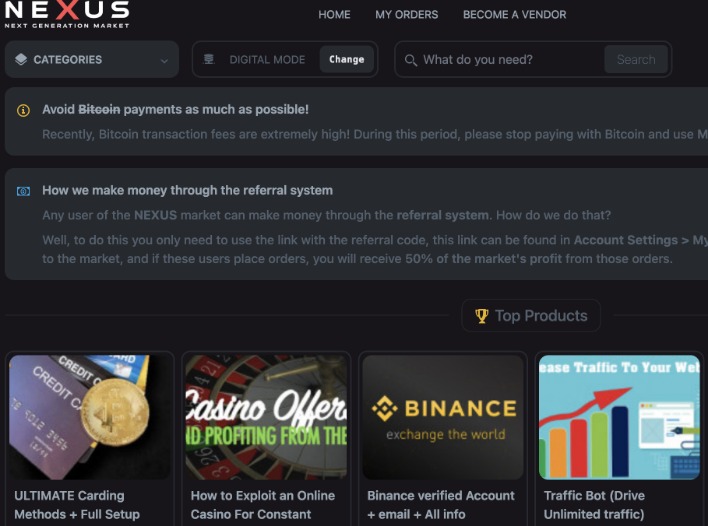The Automotive Microsystems Market: Insights from the NEXUS Market Study 2001 SpringerLink
The automotive microsystems market has experienced significant growth over the past two decades, driven by advancements in technology and increasing demand for smarter, more efficient vehicles. The NEXUS Market Study 2001 offers valuable insights into the evolving landscape of this industry, highlighting key trends, market drivers, and future prospects. For stakeholders seeking a comprehensive understanding of the current market dynamics, the nexus market link provides essential data and analysis that support strategic decision-making. As the industry continues to innovate, the role of automotive microsystems remains critical in enhancing vehicle performance, safety, and connectivity, making the nexus market link an important resource for industry participants looking to stay ahead in this competitive sector.
Remote Sellers, Marketplace Facilitators, Economic Nexus Virginia Tax
The automotive microsystems market has experienced significant growth over the past two decades, driven by technological advancements and increased demand for intelligent vehicle systems. An important aspect influencing this market is the concept of nexus, which pertains to the connection or contact point that establishes tax obligations for sellers operating across various jurisdictions. Understanding nexus is crucial for businesses navigating remote selling, marketplace facilitation, and compliance with state tax laws, particularly in regions like Virginia where economic nexus regulations are evolving.
The NEXUS Market Study 2001 highlighted the importance of accurately determining nexus to ensure compliance and optimize operations within the automotive microsystems sector. For companies involved in remote sales or marketplace facilitation, establishing whether a sufficient nexus exists can affect tax obligations and reporting requirements. The study emphasizes the role of **economic nexus**, especially in regions like Virginia, where recent tax laws have expanded definitions to include remote sellers and marketplace facilitators.
Key factors that affect nexus determination in this market include:

- Presence of a physical office or warehouse within a state
- Economic thresholds, such as sales volume or transaction counts in a specific jurisdiction
- Use of third-party online marketplaces to reach consumers
- Activities conducted by marketplace facilitators on behalf of sellers
Understanding these nexus principles helps automotive microsystems manufacturers and sellers to manage compliance risks effectively. The **nexus market link** becomes evident when companies recognize the importance of establishing clear tax responsibilities based on their operational footprint and sales channels. As laws continue to adapt, especially in states like Virginia, staying informed about nexus-related requirements remains essential for sustainable growth and legal compliance in the dynamic automotive technology landscape.
Verified Directory of Onion Links, Tor Sites & Dark Web Resources
The Automotive Microsystems Market has witnessed significant growth over the past two decades, driven by advancements in technology and the increasing integration of electronic systems in vehicles. Insights from the NEXUS Market Study 2001, available through SpringerLink, shed light on the foundational developments and future trajectories of this dynamic industry. The NEXUS market link has been instrumental in providing access to comprehensive reports and analyses that help industry stakeholders understand market trends, key players, and technological innovations in automotive microsystems.
According to the NEXUS Market Study 2001, the automotive microsystems sector is characterized by rapid technological evolution and a burgeoning demand for smart, efficient, and safe vehicle functionalities. The study identifies several critical factors impacting market growth, including advances in embedded systems, sensor technologies, and decreasing component costs. These developments have enabled automakers to embed more sophisticated microsystems into vehicles, enhancing performance, safety, and user experience.
Key insights from the NEXUS market link reveal a few essential trends shaping the automotive microsystems landscape:

- Growing adoption of electronic control units (ECUs) for various vehicle functions such as braking, infotainment, and comfort systems.
- Increasing integration of sensors for navigation, collision avoidance, and environmental monitoring.
- The shift towards more compact and energy-efficient microelectronic components to meet stringent automotive safety and environmental standards.

Furthermore, the NEXUS Market Study emphasizes the importance of partnerships and collaborations within the industry to foster innovation and accelerate development cycles. The study also highlights regional market variations, with North America, Europe, and Asia-Pacific identified as major hubs for automotive microsystem production and deployment. These insights from the nexus market link are valuable for industry players looking to understand competitive positioning and emerging opportunities.
Overall, the ongoing evolution in the automotive microsystems market reflects the broader trend toward smarter, more connected vehicles. The NEXUS Market Study remains a crucial resource for industry professionals seeking data-driven insights to navigate this complex and rapidly growing field.
What Is A Remote Seller?
The Automotive Microsystems Market has experienced significant growth and innovation over recent years, driven by advancements in technology and increasing demand for smarter, more efficient vehicles. A comprehensive understanding of this market can be gained through detailed studies such as the NEXUS Market Study 2001. This study provides valuable insights into market trends, key players, and emerging technologies that shape the future of automotive microsystems. For stakeholders and industry analysts, the nexus market link serves as a vital resource for staying informed about market dynamics and strategic opportunities.
The NEXUS Market Study emphasizes the importance of microelectronic components in automotive applications, including sensors, controllers, and communication modules. As vehicles become more connected and autonomous, the automotive microsystems market is expected to expand rapidly. This growth underscores the need for innovative solutions and robust supply chains, which are often detailed within the nexus market link, offering further guidance and market forecasts.

In the context of market development, understanding what constitutes a remote seller is also crucial. A remote seller is typically defined as a business that sells products or services without a physical storefront at the point of sale, often relying on digital channels to reach customers. This concept is increasingly relevant as automotive electronics and microsystems increasingly integrate with digital platforms and e-commerce channels, making the nexus market link an essential resource for grasping the broader market landscape and technological trends.
The Fed The Regulatory and Monetary Policy Nexus in the Repo Market
The nexus between regulatory authorities and monetary policies plays a crucial role in shaping the dynamics of the repo market. This intricate relationship influences liquidity, interest rates, and overall financial stability. Understanding the regulatory framework and its interaction with monetary policy can provide insights into market movements and potential risks. For a deeper exploration of market links and how regulatory decisions impact the repo environment, visit the nexus market link to access detailed analyses and data. Recognizing this connection helps stakeholders navigate the complex landscape of short-term lending and borrowing, ensuring robust financial operations.
The hierarchical market-firm nexus as the Japanese mode of régulation
The relationship between the Federal Reserve’s regulatory and monetary policies and the reverse repurchase agreement (repo) market forms a complex nexus that influences overall financial stability and liquidity management. This interconnectedness highlights how central bank policies directly impact short-term funding markets, shaping the behavior of financial institutions and market liquidity. The nexus market link serves as a critical conduit through which policy signals are transmitted, affecting the cost and availability of funds in the repo market. Understanding this nexus is essential for comprehending how the Fed’s regulatory framework and monetary stance influence systemic risk and market efficiency.
The hierarchical market-firm nexus, often regarded as a Japanese mode of regulation, presents an illustrative comparison. In this model, regulatory oversight maintains a hierarchical structure where financial institutions operate within a framework of interconnected relationships overseen by a central authority. This approach emphasizes stability through formalized hierarchical governance, which can mitigate market volatility. When applied to the repo market, such a nexus ensures that liquidity provision and risk management are aligned with overarching regulatory objectives, fostering resilience in the financial system.
- In a significant move to improve consumer confidence, Nexus Market has unveiled an expanded buyer protection program this February.
- These resources are crafted to ensure the next generation is well-equipped to take their family businesses to new heights, embracing modern practices while respecting traditional values.
- You’ll bring your expertise and contribute to solutions for the challenges the start-ups will encounter.
- Nexus Market Darknet – NxtGen Nexus is not just a platform; it’s a comprehensive toolkit designed to empower the upcoming generation of family business entrepreneurs.
- This alignment of service will bring significant savings to suppliers and ultimately to end consumers.
- The core argumentof the ‘Companyism’ hypothesis is that large firms are the centre of themode of régulation and have strongly promoted social integration in Japanesesociety.
The Fed’s policies, including adjustments to interest rates, open market operations, and regulatory mandates, directly influence the nexus market link in the repo environment. By controlling short-term interest rates and conducting asset purchases or sales, the Fed modifies the supply and demand dynamics of collateralized borrowing and lending. This, in turn, affects liquidity conditions and risk perception among market participants. The hierarchical nexus model offers a framework for understanding how regulatory oversight can facilitate stability, ensuring that the interconnected market linkages function smoothly even during periods of stress.
Overall, the combination of monetary policy, regulatory oversight, and market structure constructs the nexus that sustains the repo market’s integrity. Recognizing the significance of the nexus market link and the hierarchical regulatory paradigm underscores the importance of coordinated policy actions in maintaining financial stability and efficient liquidity distribution across the short-term funding landscape.
Marketplace facilitator nexus criteria in every state
The nexus between regulatory frameworks and monetary policy significantly influences the functioning of the repo market. The Federal Reserve plays a pivotal role in shaping market conditions through its monetary policy tools, which impact liquidity, interest rates, and overall financial stability. Simultaneously, regulatory oversight determines the operational boundaries and compliance requirements for market participants, fostering a balanced environment that supports both economic growth and risk mitigation. This interconnected relationship creates a complex “nexus” that market participants must navigate, particularly within the context of a volatile interest rate landscape.
Understanding the regulatory and monetary policy nexus in the repo market is essential for participants seeking to optimize their strategies while maintaining compliance. The Federal Reserve’s interventions, such as open market operations and discount window policies, influence short-term funding costs and liquidity availability. These measures often interact with state-level regulations, which establish specific criteria for marketplace facilitators operating within each jurisdiction. Marketplace facilitator nexus criteria vary across states, encompassing factors such as physical presence, economic nexus, and transaction volume, which determine the scope of tax obligations and regulatory oversight.
Maintaining compliance with the varying marketplace facilitator nexus criteria is crucial for entities engaged in the repo market. As the landscape evolves, understanding where nexus exists helps firms to navigate tax obligations, licensing requirements, and reporting standards effectively. For market participants, recognizing this interconnected web of federal and state regulations is key to managing risk and ensuring operational efficiency. The complex nexus market link emphasizes the importance of a comprehensive approach that accounts for both federal monetary policy influences and state-specific regulatory obligations to operate successfully within the market.
The AI Wealth Nexus Side Effects !MeGa $ DISCOUNTS! Side Effects, Ingredients, Consumer Reviews 2025 5D3LU
The nexus between the Federal Reserve’s regulatory and monetary policies and the repo market plays a critical role in maintaining financial stability and liquidity within the broader economy. The repo market, a vital component of short-term funding, is heavily influenced by regulatory frameworks and monetary policy decisions implemented by the Fed. Understanding this interconnected relationship helps stakeholders navigate market fluctuations and anticipate shifts driven by policy changes.
During periods of economic uncertainty or inflationary pressure, the Federal Reserve adjusts its monetary policy by altering interest rates or engaging in open market operations, which directly impact the repo market’s funding costs and liquidity levels. Regulatory measures, such as capital requirements and risk assessment standards, further influence the behavior of market participants, ensuring systemic stability but also adding layers of complexity to the market dynamics.
One significant aspect of this nexus is how the Fed’s policies can either tighten or loosen liquidity in the repo market. For example, during quantitative easing phases, the Fed’s asset purchases can increase liquidity, reducing borrowing costs. Conversely, tightening policies may lead to higher rates and reduced short-term funding availability. This delicate balance underscores the importance of an integrated approach to regulation and monetary policy, particularly as market players react to policy signals and regulatory adjustments.
With the evolving landscape of financial instruments and digital innovations, new market linkages have emerged, such as the role of AI and automation in trading and risk management. These advancements, often branded with terms like “The AI Wealth Nexus,” can have side effects that influence liquidity, market volatility, and investor behavior. Understanding these side effects is crucial for market participants aiming to navigate the nexus of policy and market linkages effectively.
For consumers and investors exploring financial products like MeGa $ DISCOUNTS, being aware of potential side effects and ingredient transparency is essential—especially as these products enter the 2025 market. Monitoring reviews and understanding the ingredients can help users make informed decisions amid a complex nexus of market influences and technological innovations.
- Regulatory frameworks shape the operational environment of the repo market.
- Monetary policy decisions impact liquidity and short-term funding costs.
- Emerging AI technologies influence market dynamics and investor behavior.
- Consumer awareness is vital when navigating complex financial products and their side effects.


